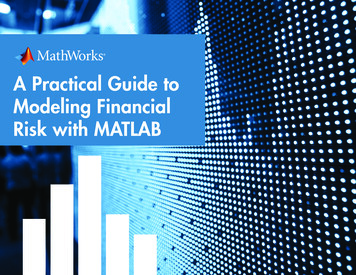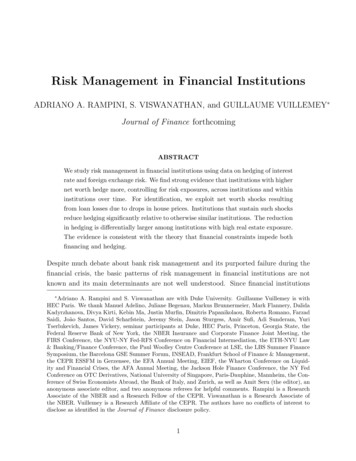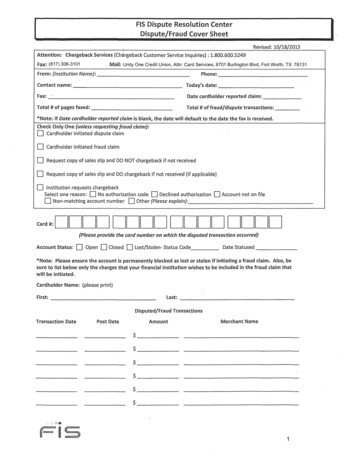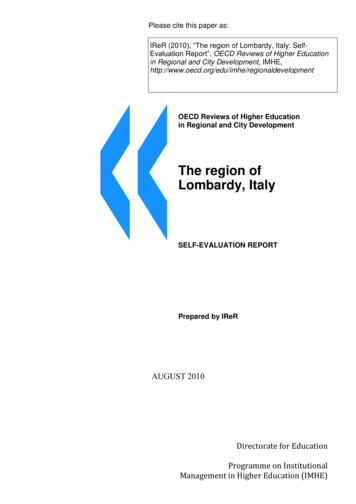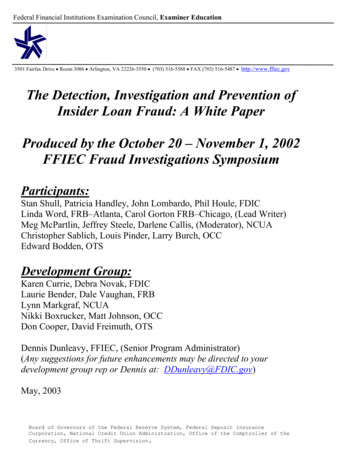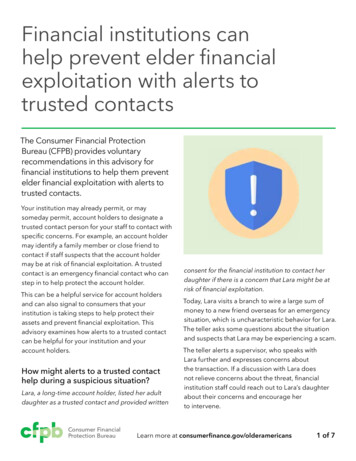
Transcription
Financial institutions canhelp prevent elder financialexploitation with alerts totrusted contactsThe Consumer Financial ProtectionBureau (CFPB) provides voluntaryrecommendations in this advisory forfinancial institutions to help them preventelder financial exploitation with alerts totrusted contacts.Your institution may already permit, or maysomeday permit, account holders to designate atrusted contact person for your staff to contact withspecific concerns. For example, an account holdermay identify a family member or close friend tocontact if staff suspects that the account holdermay be at risk of financial exploitation. A trustedcontact is an emergency financial contact who canstep in to help protect the account holder.This can be a helpful service for account holdersand can also signal to consumers that yourinstitution is taking steps to help protect theirassets and prevent financial exploitation. Thisadvisory examines how alerts to a trusted contactcan be helpful for your institution and youraccount holders.How might alerts to a trusted contacthelp during a suspicious situation?Lara, a long-time account holder, listed her adultdaughter as a trusted contact and provided writtenConsumer FinancialProtection Bureauconsent for the financial institution to contact herdaughter if there is a concern that Lara might be atrisk of financial exploitation.Today, Lara visits a branch to wire a large sum ofmoney to a new friend overseas for an emergencysituation, which is uncharacteristic behavior for Lara.The teller asks some questions about the situationand suspects that Lara may be experiencing a scam.The teller alerts a supervisor, who speaks withLara further and expresses concerns aboutthe transaction. If a discussion with Lara doesnot relieve concerns about the threat, financialinstitution staff could reach out to Lara’s daughterabout their concerns and encourage herto intervene.Learn more at consumerfinance.gov/olderamericans1 of 7
Once she knows about the situation, Lara’sdaughter might help Lara by:In 2016, the CFPB released voluntaryrecommendations for financial institutionsthat included enabling account holdersto consent to sharing information withtrusted third parties. ion/§ Asking questions to help Lara stop and thinkcritically about the situation§ Helping Lara determine whether this is alegitimate transaction§ Explaining to Lara that this sounds like a scamand she should not wire the funds§ Helping Lara to: Find out whether anyone else has accessedLara’s financial information Stop that access File a report with the police or otherauthorities§ Determining whether Lara needs extra supportto manage her money and setting up a fiduciaryif necessary§ Discussing how to prevent future problemsand how to respond if something like thishappens againBecause Lara provided advance consent for herfinancial institution to alert a trusted contact in caseof suspected financial exploitation, Lara’s financialinstitution can help her get more support andpotentially prevent her from sendingthe money.Note on fiduciaries and representatives:The Gramm-Leach-Bliley Act (GLBA) permitsfinancial institutions to share information with“persons acting in a fiduciary or representativecapacity on behalf of the consumer” withoutproviding the account holder with notice andan opportunity to opt out. For example, if Larahad a court-appointed guardian, under GLBAa financial institution would not need to getLara’s advance consent to share informationwith that person. See 12 CFR § 1016.15(a)(2)(v).Consumer FinancialProtection BureauThe following voluntary practicesmay be helpful when consideringwhether and how to provide alertsto trusted contacts:Develop clear policies and procedures§ Create a policy that explains when and how yourstaff can reach out to a trusted contact.§ Establish a procedure for requesting advanceconsent from account holders to share certaininformation with a trusted contact when certainsituations occur. Offer this option to accountholders of all ages. Identify the situations in which your staffmay alert the trusted contact. For example,you could alert the trusted contact if youare unable to contact the account holder, ifa discussion with the account holder doesnot relieve staff concerns about the threat offinancial exploitation, to confirm the accountholder’s health status, or to confirm theidentity of a new guardian, trustee, executor,or power of attorney holder. You can ask account holders to identifymultiple trusted contacts, in case the primarytrusted contact is unavailable or is suspectedof exploiting the account holder.§ Consider asking account holders to designate atrusted contact at account opening and revisitingLearn more at consumerfinance.gov/olderamericans2 of 7
the consent on a regular basis and when certainchanges or events occur. For example, you couldreview the consent if the account holder addsan additional owner to the account, establishesa new power of attorney or trust, or experiencesfinancial exploitation. Or, if an account holderexpresses concerns about financial exploitation,you could suggest that they appoint a trustedcontact to help protect themselves.§ Account holders may have concerns aboutprivacy, family dynamics, or maintaining financialindependence. Develop model language fortalking about these issues so consumers canfeel more comfortable with choosing a trustedcontact. For example, it may be helpful to explainto the account holder that this feature addsan extra layer of security to the account, andclarify that the trusted contact cannot view theaccount or make any transactions or decisionsabout the account unless they have some otherlegal authority, such as guardianship or power ofattorney.§ Encourage account holders to talk to theirtrusted contact to explain that your staff mayreach out to them in certain situations.§ Develop model language for the informationthat staff may disclose in a phone call, in-personconversation, email, or other type of alert to thetrusted contact.§ Consider which type of staff person is bestqualified to discuss a suspicious situationwith the account holder or trusted contact.For example, this could be a staff memberwho is trained on financial exploitation andcommunicating with older adults aboutsensitive issues. It may be helpful to limitaccess to the trusted contact’s information toConsumer FinancialProtection BureauThe federal Senior Safe Act providesthat financial institutions are not liablefor reporting suspected elder financialexploitation to covered agencies if thesituation meets certain criteria. To establishimmunity, the report must be made ingood faith and with reasonable careand the employee must have receivedappropriate training on how to identifyand report elder exploitation. The SeniorSafe Act also provides individual immunityfor certain individuals. The Senior Safe Actapplies to depository institutions, creditunions, investment advisers, broker-dealers,insurance companies, insurance agencies,insurance advisers and transfer agents. SeniorSafe Act, 12 U.S.C. § 3423(a) (2018).Banks and credit unions that are interestedin implementing trusted contacts may findinformation on this topic from SEC or FINRAhelpful, although the material is targeted forthe broker-dealer industry.FINRA’s Rule 4512 12) states thatfirms can alert a trusted contact person and“disclose information about the customer’saccount to address possible financialexploitation, to confirm the specifics of thecustomer’s current contact information,health status, or the identity of any legalguardian, executor, trustee or holder of apower of attorney, or as otherwise permittedby Rule 2165.” For more information abouthow trusted contacts work in the brokerdealer industry, see ncialexploitation-seniors.Learn more at consumerfinance.gov/olderamericans3 of 7
certain designated staff members, in order toreduce the risk of an inadvertent disclosure ofconfidential account information.§ Develop a process for what staff should do if thetrusted contact is the suspected bad actor. Forexample, staff could ask the account holder todesignate a second trusted contact, and staffcould contact Adult Protective Services and/orlocal law enforcement for assistance. You can note on your trusted contact formthat staff members will use their discretion todetermine whether to alert the trusted contactin any given situation.Educate and support youraccount holders§ Develop concise, plain-language writtenmaterials in large, readable fonts about yourpolicies and procedures. This could include awritten disclosure you provide to the accountholder when they appoint a trusted contact. Youcould describe the purpose for the consent form,situations when you might reach out to a trustedcontact, the type of information staff maydisclose to a trusted contact, issues for theconsumer to consider when deciding whetherto execute the form, and how to choose asuitable trusted contact. A study found that consumers were morelikely to appoint a trusted contact when thetrusted contact form included three things:a statement about the prevalence of fraud,a statement that most people support theconcept of a trusted contact person, and arequirement for the account holder to makean active choice about whether to appoint atrusted contact. le 20201109 11790 ghts.pdfConsumer FinancialProtection Bureau Before implementing a consent form, considergathering feedback about the draft fromolder adults and professionals who work witholder adults.§ Consider allowing account holders to selectspecific situations where your staff can reachout to the trusted contact. For example, on theconsent form, you could provide a checklist withoptions they can choose.§ Inform account holders that they have theright to revoke the consent at any time or toexecute a new consent and name a differenttrusted contact.§ Inform account holders that although choosinga trusted contact does not give that person theright to view their account or make any decisionsabout the account, it is possible that theperson could use other methods to try to takeadvantage of them. Inform them that you willnot share information with the trusted contact ifyour staff reasonably suspects that the trustedYou can download or order CFPB’sresources in bulk for free and share themwith your account holders. Here are a fewexamples:§ Managing Someone Else’s Money guidesfor financial caregivers: consumerfinance.gov/msem§ Money Smart for Older Adults scamprevention program: consumerfinance.gov/moneysmart§ Planning for diminished capacity andillness: earn more at consumerfinance.gov/olderamericans4 of 7
You can build on your institutional knowledgeand celebrate your team by incorporating realstories of incidents in which staff intervenedsuccessfully to help an older account holderprevent financial exploitation.§ Develop talking points for your staff to use whenasking account holders to choose a trustedcontact. It may also be helpful to develop talkingpoints for walking an account holder through theconsent form.contact has exploited or will exploit theaccount holder.Train and support your staff§ Develop a training culture at your financialinstitution that incorporates frequent educationon elder financial exploitation. Cyclical, recurring training will help integrateawareness of this important topic into dailyroutines and ensure staff know how torespond when they suspect financial abuse.It may be helpful to walk staff through somecommon scenarios and discuss how yourfinancial institution could reach out to atrusted contact for help.A variety of national, state, and local entities,such as government agencies, nonprofitorganizations, and trade groups, offer freetrainings to help financial professionalsprevent elder financial exploitation. Staff should know how to recognizetransactional and behavioral red flags andhow to report elder financial exploitation toAdult Protective Services (APS) and/or lawenforcement, in accordance with state andfederal laws.Consumer FinancialProtection Bureau§ Develop talking points for your staff to usewhen communicating with an account holderor trusted contact about suspected financialabuse. You may need different talking points forfront line staff and supervisors. Make sure staffunderstand that the trusted contact may declineto get involved in the situation.The CFPB, Treasury, and FinCEN issued ajoint memorandum in 2017 to encouragecoordination among financial institutions,law enforcement, and Adult ProtectiveServices (APS) to protect older adultsfrom financial abuse: ent-efforts-combat-elder-financialexploitation/In 2019, the CFPB released updatedinformation for financial institutions aboutreporting elder financial sory-andrecommendations/Learn more at consumerfinance.gov/olderamericans5 of 7
About usThe Consumer Financial Protection Bureau(CFPB) is a 21st century agency that helpsconsumer finance markets work by makingrules more effective, by consistentlyand fairly enforcing those rules, and byempowering consumers to take morecontrol over their economic lives.Learn more at consumerfinance.govReview state and federal laws§ Review the Gramm-Leach-Bliley Act’s notice andopt out requirements.§ State privacy laws and other state and federallaws may impact the account holder’s abilityto designate a trusted contact, the content ofthe consent form, or other issues related to theconsent. This advisory does not supersede thoserequirements.The CFPB, along with several otherfederal agencies, issued guidance in2013 to financial institutions to clarify theapplicability of privacy provisions of theGramm-Leach-Bliley Act (GLBA) to reportingsuspected financial exploitation of olderadults: deradults/Consumer FinancialProtection BureauConnect with us Submit a complaintconsumerfinance.gov/complaint Tell your storyconsumerfinance.gov/your-story Ask CFPBconsumerfinance.gov/askcfpb Share your thoughtsfacebook.com/cfpbtwitter.com/cfpbThis document includes links and references to thirdparty resources or content that consumers may findhelpful. The Bureau does not control or guarantee theaccuracy of this third-party information. By listing theselinks and references, the Bureau is not endorsing and hasnot vetted these third parties, the views they express, orthe products or services they offer. Other entities andresources also may meet your needs.Learn more at consumerfinance.gov/olderamericans6 of 74/2022
Consumer FinancialProtection BureauLearn more at consumerfinance.gov/olderamericans7 of 7
to trusted contacts: Develop clear policies and procedures § Create a policy that explains when and how your staff can reach out to a trusted contact. § Establish a procedure for requesting advance consent from account holders to share certain information with a trusted contact when certain situations occur. Offer this option to account
